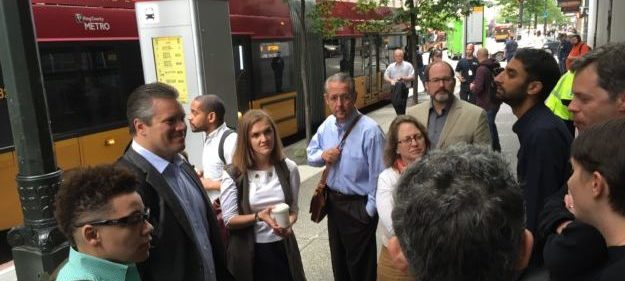

Less than a month ago, TransitCenter concluded the inaugural round of our transit agency board member training program, produced in partnership with the Institute for Transportation and Development Policy.
We’ve been pleased (though hardly surprised) by the high degree of enthusiasm from our participants. Eleven in all, they hail from the boards of transit agencies across the country as big as Boston’s MBTA and as small as the Ann Arbor Area Transportation Authority—with quite a diverse group in between. In no small part thanks to the degree of engagement from these board members, TransitCenter intends to continue the program into second and subsequent “classes” beginning later this year.
The idea behind the board member training program is simple: transit agency boards have the power—often more so than agency staff or elected officials—to craft policies and set out visions that make transit stronger and more useful. Within the relatively insular world of public transportation, board members wield authority without having to endure decades climbing the lower ranks of agency bureaucracy, or waiting for new and interesting ideas to become universally accepted. One of the most high-profile innovations in recent transit policy is the redesign of Houston’s bus network, which has brought more frequent service to thousands of people and is likely responsible for a recent spike in ridership. That reform originated not within agency management, but with Metro Houston board member Christof Spieler.
Despite their substantial authority, however, board members often come from non-transit or urban-planning backgrounds, instead taking cues from staff in a conservative industry that in many places is suffering from long-term stagnation or outright decline. TransitCenter and ITDP’s board member training program exposes participants to the full potential of their roles as board members through on-site meetings, lectures, and planning sessions with transit agency and transportation department officials in cities that are leading the vanguard of transit improvement and policy reform. The site visits underscore the program’s emphasis on outcomes rather than processes; TransitCenter’s goal is not merely to teach participants how to effect reforms in theory, but to show what those reforms do for everyday transit riders.
After first meeting in Houston in March, the inaugural class of the program concluded at the end of June in Seattle. TransitCenter did not choose these cities by happenstance, but rather because they are fine examples of the progress that every American city should strive to make on transit policy.
In Houston, known for its sprawling form and 23-lane highways, the revamped bus network is demonstrating that substantial increases in ridership can occur in the least likely of cities—provided that riders are given buses and trains that arrive often and get people where they want to go. Spieler made invaluable contributions to the gathering, recounting experiences steering reform from his seat on the Metro board (and, prior to his service, as an activist blogger on transit issues).
Seattle has always been more compact and walkable than Houston, but is similarly one of the only large cities in the country that has seen healthy growth in bus ridership since the recession, thanks in part to a unique contractual arrangement between the city and the county-run transit agency that mandates additional city-funded bus service in Seattle proper. Our class had the opportunity to speak with staff and board members from the Seattle Department of Transportation as well as Sound Transit and King County Metro, the region’s two major transit providers. They also spent time in walkable, transit-oriented neighborhoods to see how good land use policies help build and reinforce transit investments.

The transit agency board members met with Seattle Department of Transportation Director Scott Kubly
With these visits, TransitCenter sought to eliminate the grass-is-greener inaction that too often stymies transportation progress—the kind that held back bicycle improvements in New York for years because “it’s not Amsterdam” and transit improvements in other cities because “we’re not New York.” To this end, the program concluded with collaborative work on action plans to increase transit use in each of the cities that sent participants. The relationships formed and lessons shared are part of a growing body of practice and network of relationships across America’s cities—all of which we believe will, in time, create pressure for more effective transit systems and reform of America’s transportation policies.
 On the Brink: Will WMATA’s Progress Be Erased by 2024?
On the Brink: Will WMATA’s Progress Be Erased by 2024?
The experience of being a WMATA rider has substantially improved over the last 18 months, thanks to changes the agency has made like adding off-peak service and simplifying fares. Things are about to get even better with the launch of all-door boarding later this fall, overnight bus service on some lines starting in December, and an ambitious plan to redesign the Metrobus network. But all of this could go away by July 1, 2024.
Read More New TransitCenter Report: To Solve Workforce Challenges Once and For All, Transit Agencies Must Put People First
New TransitCenter Report: To Solve Workforce Challenges Once and For All, Transit Agencies Must Put People First
TransitCenter’s new report, “People First” examines the current challenges facing public sector human resources that limit hiring and retention, and outlines potential solutions to rethink this critical agency function.
Read More